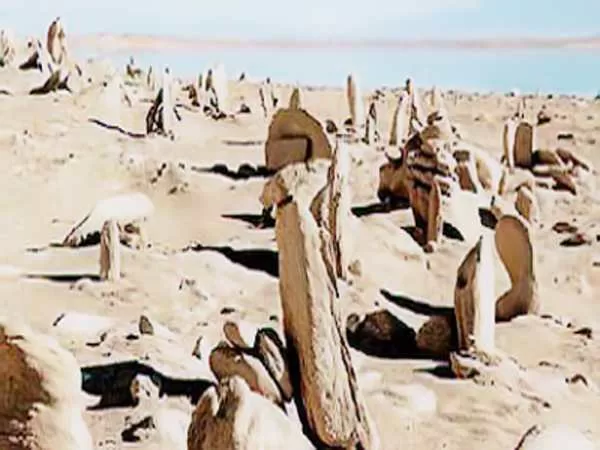The Baigong Pipes
In the remote beauty of Delingha, Tibet, lies a mystery that has both intrigued and perplexed many: the Baigong Pipes. Nestled near the Qaidam Basin and encased in the rugged landscape of Mt. Baigong, these pipes are purportedly ancient metal structures embedded in rock formations. The pipes, which some claim to be the remnants of an alien construction project from 150,000 years ago, have sparked considerable debate and fascination.
The Baigong Pipes consist of a network of metal tubes found in a cave on Mt. Baigong. These pipes, which protrude through the cave walls and extend into the nearby salt lake, are said to date back far beyond any known historical period. Their discovery in 1996 by author Bai Yu brought the pipes into the spotlight, raising questions about their origin and purpose.
According to Bai Yu’s account, the cave where the pipes were found is triangular and about six meters deep. The pipes, some as wide as 40 centimeters, were embedded in the cave’s walls and floor. Bai Yu sent a sample of the pipes to the Ministry of Metallurgical Industry, which reported that the pipes contained 92% common minerals and metals, with 8% of an unknown composition. This finding fueled speculations that the pipes were remnants of an advanced civilization or even extraterrestrial visitors.
In 2001, a team from the China Seismological Bureau examined the pipes. Their thermoluminescence dating suggested that if these were iron pipes, they might be as old as 140,000 to 150,000 years. Since human history in the region only extends back about 30,000 years, the dating of these pipes seemed to support the theory of alien intervention. This sensational idea gained traction, especially after a 2002 Xinhua News Agency article highlighted the study and the mysterious origins of the pipes.
The theory of alien origins was further bolstered by the local creation of a monument featuring a mock-up metallic satellite dish, drawing visitors and enthusiasts who speculated about the pipes’ extraterrestrial connections. Online forums buzzed with discussions about the supposed suppression of follow-up reports, suggesting a cover-up by the Chinese government.
However, while the alien theory captures the imagination, it is not the only explanation for the Baigong Pipes. Responsible inquiry requires considering natural explanations before resorting to extraordinary claims. Skeptics have proposed various geological processes to account for the pipes.
One theory suggests that the pipes could be the result of natural geological processes. The Chinese proposed that iron-rich magma might have seeped into fissures in the rock. This theory posits that magma, when combined with subsequent geological processes, could create rust-like structures resembling pipes. However, this hypothesis was dismissed due to the lack of supporting evidence and the presence of the Qaidam oil field, which would not be feasible if there had been active volcanism in the area 150,000 years ago.
Another, more widely accepted theory involves the erosion and sedimentation processes. Researchers hypothesize that iron-rich sediment from ancient floods might have filled fissures in the sandstone. Over time, these sediments, combined with hydrogen sulfide gas, could have hardened into structures resembling metallic pipes. This theory aligns with the geological history of the Qaidam Basin, which experienced significant flooding and sedimentation.
Supporting this natural explanation, researchers have drawn parallels with similar findings elsewhere. For example, fossilized tree casts in Louisiana have been found to form cylindrical structures in the soil. These structures, dated between 75,000 to 95,000 years ago, result from pedogenesis and diagenesis—the processes by which soil becomes rock. The comparison with the Baigong Pipes suggests that they could be fossilized tree casts rather than artifacts of an advanced civilization.
Chinese scientists eventually reached this conclusion. Using atomic emission spectroscopy, they found that the rusty pipe fragments contained organic plant matter, including tree rings. This analysis indicated that the Baigong Pipes are, in fact, fossilized tree casts rather than remnants of alien technology.
The Qaidam Basin, once a vast lake, uplifted to its current elevation due to the Qinghai-Tibet Plateau’s geological activity. Over time, floods deposited alluvium and debris, including these fossilized structures. Bai Yu’s discovery, therefore, represents a natural formation rather than evidence of extraterrestrial visitation.
In summary, while the Baigong Pipes initially sparked imaginations with their alien theory, scientific investigation offers a more plausible explanation. The pipes are likely fossilized tree casts formed through natural geological processes rather than the remnants of an ancient alien construction project. This case illustrates the importance of following the scientific method and considering natural explanations before jumping to extraordinary conclusions.

